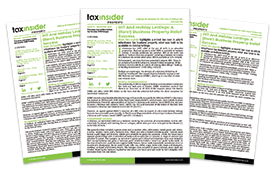Before you go, sign up to our free tax saving email course. Get 7 top property tax saving strategies in your email inbox that will help you save thousands in tax. Unsubscribe any time.
|
The principal private residence (PPR) relief rules for capital gains tax purposes require a dwelling to have been a ‘residence’ of the individual to whom the gain accrues (TCGA 1992, s 222(1)). What is a ‘residence’? The term ‘residence’ is not defined in the PPR relief legislation. However, case law indicates that the requirement for the dwelling to be a residence is more about the quality of occupation than the length of time the property was occupied. For example, in Goodwin v Curtis [1998] STC 475 it was considered that for a dwelling to qualify as a residence there must be ‘some assumption of permanence, some degree of continuity, some expectation of continuity’. There is no ‘safe’ period of occupation before a dwelling constitutes an individual’s residence. HM Revenue and Customs (HMRC) confirms in its Capital Gains manual (at CG64427): ‘There is no minimum period of occupation that would enable an individual to establish a residence’. HMRC’s guidance adds: ‘Every case must be decided upon its own particular facts.’ HMRC may look at factors including the number of property transactions in seeking to establish whether a dwelling was occupied as the individual’s PPR. A degree of permanence? For example, in Fitzjohn v Revenue and Customs [2019] UKFTT 488 (TC), the taxpayer (an estate agent) resided at the matrimonial home with his wife and two children. In 2005, he moved out of the house due to matrimonial difficulties. He moved to another address (‘Regents Court’), which he purchased on 31 December 2005 for £82,500. He sold Regents Court on 29 March 2006 for £93,000. He did not claim that Regents Court was his PPR, as it was only a temporary place to stay. On 21 April 2006, the taxpayer purchased another property (‘Silver Street’) for £88,000; he sold it on 24 August 2006 for £124,995. On 2 May 2006, the taxpayer purchased another property (‘Bringhurst’) for £81,000; he sold it on 31 October 2006 for £97,000. The taxpayer did not disclose the gains in respect of Silver Street and Bringhurst on his self-assessment return for the tax year 2006/07, on the basis that PPR relief was due. However, HMRC considered that PPR relief was not due because the taxpayer’s stay at the properties was not sufficiently settled to constitute residence. The taxpayer lost his appeal. The First-tier Tribunal noted that when the taxpayer acquired Silver Street and Bringhurst he was hopeful of a reconciliation with his wife. He owned Silver Street for approximately four months and Bringhurst for approximately six months. It seemed to the tribunal that the taxpayer did not occupy those properties with the necessary expectation of permanence required for PPR relief purposes. Practical tip Interestingly, the tribunal in Fitzjohn also noted that the taxpayer was an experienced local estate agent; it seemed likely that the taxpayer saw an opportunity to deal in properties, using his expertise to spot attractive deals. This underlines the point that every case is different and must be considered on the particular facts. This is a sample article from the monthly Property Tax Insider magazine. Go here to get your first free issue of Property Tax Insider. |


 Tax Articles
Tax Articles
 Mark McLaughlin looks at the distinction between occupying a dwelling as a ‘residence’ or to make a profit on sale following a short period of ownership.
Mark McLaughlin looks at the distinction between occupying a dwelling as a ‘residence’ or to make a profit on sale following a short period of ownership.